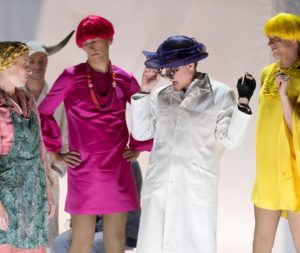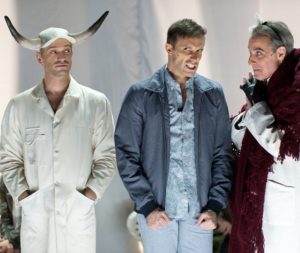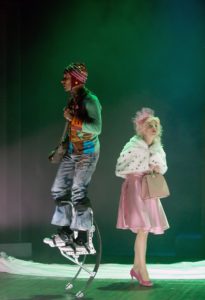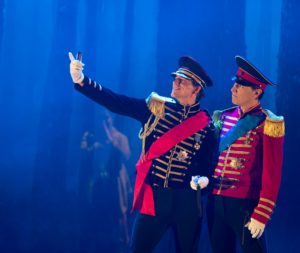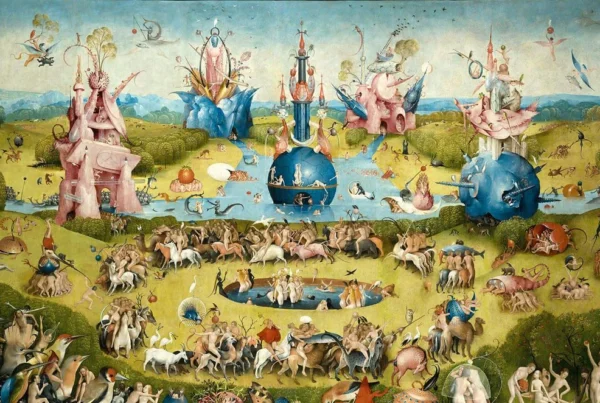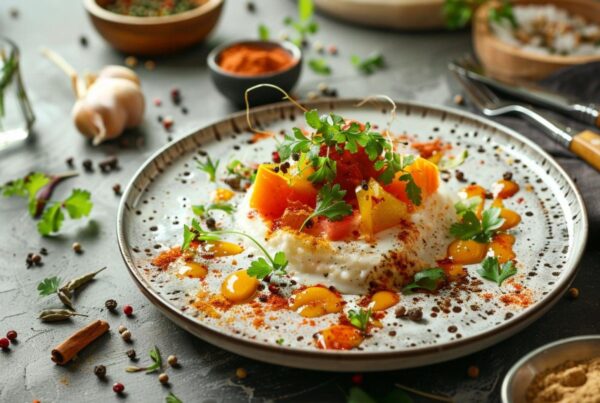Author: Kat Mokrynski
Photos: Frédéric Lovino
Earlier this month, Opéra de Reims hosted two performances of Into the Woods, a musical by the legendary composer Stephen Sondheim. Narrated in French and performed with English with subtitles, Into the Woods combines the stories of multiple beloved fairytale characters including Rapunzel, Cinderella, Little Red Riding Hood, Jack from Jack and the Beanstalk, and more. There were also some new faces like the baker and his wife from the original Brothers Grimm version of Rapunzel. Similar to Avengers: Infinity War, this epic crossover of fairytale stories is even darker than before. The main premise of the musical is that each character has a wish: the baker and his wife wish for a child, Cinderella wishes to go to the ball, Jack’s mother wishes for a new house, Jack wishes to keep his only friend (a cow named Milky White), Little Red Riding Hood wishes to visit her grandmother. This list goes on. The tale is told by a narrator who eventually gets involved in the story himself, bringing the audience along with him.
Scott Emerson shines both as the narrator as well as four other characters: Jack’s mother, the stepmother, a mysterious man, and the grandmother of Little Red. He is quick and amusing in both French and English, easily switching between the two languages while speaking and singing. Jérôme Pradon plays a baker, charming the audiences with his lovely tenor and top-quality acting. He works well with Jasmine Roy, the baker’s wife who quickly changes from a naive young wife to a hardened and disillusioned woman throughout the course of the play. While Gregory Garell (Jack) and Charlotte Ruby (Little Red Riding Hood/Rapunzel) acted well with the ensemble, their weak vocals and multiple voice cracks failed to draw in the audience. But among the most impressive cast members is Alyssa Landry who plays the witch. Her soaring vocals, brilliant acting and quick dialogue enrapture the audience, making them question her character’s true motives.
The entirety of act one is dedicated to how each of the characters’ wishes are connected by “the woods” and the conniving Witch. The Witch had her magic beans stolen by the baker’s father, so she cursed his family with infidelity. In order to have the curse lifted, he must provide her with a “cow as white as milk” (one could say Milky White), a “cape as red as blood” (sound familiar?), “hair as yellow as corn” (if only there was someone with hair to spare…), and a “slipper as pure as gold” (need I say more?). Eventually, all of the characters find each other in the woods and use each other to reach their goals in an attempt to reach “happily ever after”. Without getting into spoiler territory, act two proves that sometimes wishes can come true but with a high price, as things begin to turn sour for all of the characters, both villainous and heroic.
Usually, Into the Woods is performed in two different ways. The first is to follow the Broadway production by transforming the stage into a fairytale world. Actors wear extravagant costumes and lush trees crowd the stage, making the audience feel like they are in a storybook. The other takes on a more simplistic adaptation, with actors in simple costumes and a piano as the main set piece on stage. With the minimalist view, audiences are able to create their own world with their imagination. The Clef des Chants theater company chose to combine the two. The musical begins with a white couch and a white sheet. Once the woods are introduced, the sheet falls to reveal the set designer, Gregory Leteneur’s, artistic representation of trees: tall columns that are able to light up and be moved around the stage by the cast. These “trees” give the woods an unnatural feeling that one might expect with such an unusual take on traditional fairy tales.
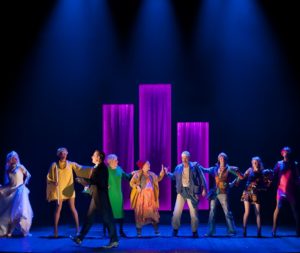
The colorful panels representing the forest were a bold move by the Clef des Chants theater company. Photo: Frédéric Lovino
While the set was enjoyable, the feeble attempt to modernize the story failed to capture the audience. The only aspect of the show that is truly “modern” is the costumes by Frederic Olivier who uses a range of fashion, from the late 20th century to current outfits. This choice blends well with the set, but sometimes the bold modern choices distract the audience from the story (one main example is Jack’s strange “stilts” that come in with no explanation).
A phone is used once by Rapunzel’s Prince for a selfie, but it comes off as a cheap joke as there is no other technology in the show (excluding the Witch’s “magic wand”, a double-sided lightsaber-esque staff). There is some sparse dancing that is ineffective and feels out of place compared to the dark tone and the ballads on the show.
Into the Woods tried to appear revolutionary by using minimalistic set design with a modern twist, but it ended up leaving audiences a bit lost in the woods.
Kat Mokrynski is a first-year Euram student writing for the Culture section of The Sundial Press. She was born and raised in Pennsylvania near Philadelphia, the land of cheesesteaks and crazy sports fans. Her previous experiences with journalism include interviews with Javier Muñoz (Hamilton), Kendra Kassebaum (Come From Away), Stephanie Styles (Newsies), and even the great-great-grandson of Charles Dickens. When she’s not studying, Kat can be found petting dogs, listening to Broadway soundtracks, or exploring Disneyland Paris.
Make sure to check out future performances here in Reims at www.operadereims.com
Other posts that may interest you:
- The Trouble with ‘Ecocide’
- Carbon dioxide removal – hit or miss?
- Local Victories for Turkish Opposition — A Sign of Hope?
- Are France and Japan a Mismatch Made in Heaven?
- A Reflection on Dark Tourism
Discover more from The Sundial Press
Subscribe to get the latest posts sent to your email.



